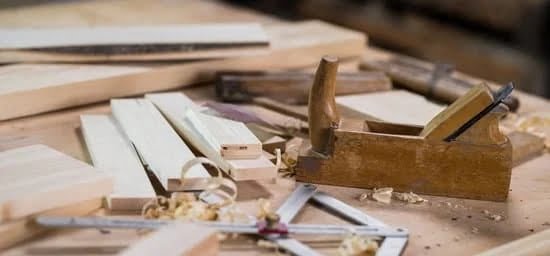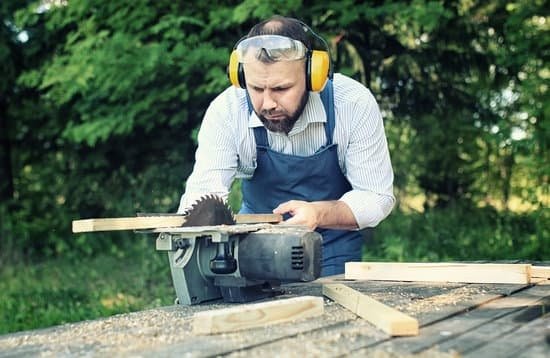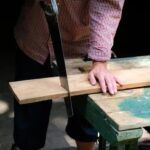Introduction
Woodworking machines are specialized tools used in the construction of furniture, musical instruments, and other wooden items. These machines help to automate some of the steps that would otherwise have to be done manually, making them invaluable to both professional woodworkers and hobbyists alike. There is an array of different types of machinery for woodworking, with each one having its own specific purpose or function. Common machines used in woodworking include saws, sanders, routers, planers, jointers, lathes and milling machines. Each machine is designed to perform different tasks to shape and work with wood materials in various ways while reducing labor time and ensuring accuracy.
Saws are essential tools used in many wood projects that involve cutting parts and pieces of wood into exact shapes and sizes. Table saws come in various sizes, allowing woodworkers to make cuts quickly while achieving very precise measurements. Circular saws can be handheld or attached to a bench top stand for more controlled use when cutting boards or larger pieces of timber into smaller components. Band saws use a continuous looped blade system which makes it easy to follow curves in the material as well as straight cuts on thicker timber.
Sanders are also needed for finishing furniture or other wooden items as they allow for quick removal of materials like paint or varnish as well as smoothing out surfaces before painting or staining projects. Sanders can range from motorized models that rapidly shave down irregular surfaces down hand-held palm sanders ideal for small details on your project.
Routers are another type of machine found in many professional workshops that provide detailed carving and shaping capabilities on the surface layer of what you’re working on; these machines have interchangeable bits that create a wide variety of ornamental effects like chamfering or engraving along certain edges as desired by the user. Planers are similar yet more generalized machines which ride over the surface material on adjustable motors allowing easier cutting versus hand planing tools; they also slightinly reduce thickness while being worked upon so be sure not to remove too much material at once!
Other useful machines such as jointers are similar yet instead rely upon two spinning cutter heads which grind against each other at right angles creating perfectly even joints between piece A and B while lathes rotate sections slowly so that intricate shapes can be achieved via hand tools being pushed against it such as chisels; finally there are milling machines which employ motorized cutters placed up against the object itself usually in vertical configurations resulting highly accurate results with complex operations such that cannot be replicated by any other method quickly!
Different Types of Woodworking Machines
Woodworking machines are a key piece of equipment used in woodworking projects, ranging from small-scale home repairs to large-scale construction. There are many different types of woodworking machines available, each designed with specific features and benefits to meet the needs of various types of projects. Commonly used machines include table saws, band saws, joiners, lathes, routers, planers, drill presses and sanders.
Table saws are typically the primary machine for cutting stock of any size in both outlined shapes and dadoes. Typically table saws have specially sharpened blades which spin at high speeds and finely slice through most woods without much additional force from the user. The blade is adjusted according to the desired size of cut being achieved by adjusting the height.
Band saws are a type of machine that feature a continuous looped blade for rectangular cuts or curved patterns as opposed to straight cuts found using a tablesaw. The blades on band saws generally run at much lower speeds than those found on table saws but can still make very precise cuts. Band saws are commonly used when creating cabinetry frames or cutting larger blocks of material into pattern pieces such as half-circles or other shaped slots.
Joiners help create joints between two pieces of wood and are commonly used when building cabinets or furniture pieces. Joiners can be equipped with multiple heads depending on the joint being created including slot-cutting heads which screw into place in order to precisely mortise two workpieces together securely eliminating need for glue or fasteners.
Lathes use a spinning bit held against a surface at consistent angles for splining applications where curves can be created along exact angles and sizes with minimal waste material leftover post-cut. Lathes come in both large-scale industrial models and compact versions for use in smaller home shops more commonly known as “mini lathes”.
Routers generally feature several interchangeable bits that operate similarly to large drills or rotary tools like dremels. Routers allow significantly increased precision when cutting routed edges like dados (short horizontal grooves) or rabbets (angle cuts). This tool is often preferred over other cutting methods because it leaves behind clean edges that require less finishing work afterwards compared to more traditional hand chisel methods.
Planers use interchangeable blades arranged directly behind each other that take turns shaving off small amounts of stock as it passes over them similar to how a belt sander works but creates more consistent results due to its multiple blades operating in tandem rather than just a single sanding belt moving across one surface at a time making this an ideal tool for creating perfectly flat surfaces in little time overall..
Drill presses employ motors fixed firmly onto their frames which exert downward pressure through powerful spinning bits producing precision holes quickly without having human hands getting worn out from extended manual labor operations saving users hours upon hours worth of tedious screwnosing around with hand drill bits himself/ herself trying make correctly sized holes..
Finally Sanders utilize abrasive surfaces powered by electrical motors move back and forth quickly grinding away unevenness found on wood surfaces preparing them smoothness before adding sealant finishes onto them perfect final polished look they deserve finish pieces off they’ve already been working hard crafting long before joining wonderful carpentry family world wide!
How Woodworking Machines Can Enhance a Woodworking Project
Woodworking machines are an essential tool for any woodworker, as they can make the entire crafting process easier, faster and more precise. By using various types of specialized machines, you can quickly shape, cut and carve a variety of complex and intricate shapes out of wood with greater accuracy than is possible by hand alone. Machines also allow you to produce finished products that are of higher quality and arrive at your customers in better condition.
Woodworking machines come in many varieties, including table saws, jointers, planers, router tables and lathes. In additional to these tools there are also other more specialized tools such as tenoners for creating mortise-and-tenon joints on furniture pieces; dovetail jigs for creating dovetail joints; biscuit joiners for gluing corners together; routers for carving out decorative details; sanders for smoothing rough edges; shapers for routing edging styles into raised-panel doors and drawer fronts; oscillating spindle sanders for smoothing curved surfaces; bandsaws for cutting circles or curves into thicker or harder woods. With all these options available to the woodworker it is easy to understand why machines have become so important when tackling even the most advanced projects.
By using a combination of modern machines specifically designed with woodworkers in mind, one can drastically reduce the amount of time spent preparing materials, thereby significantly increasing project output while maintaining precision and accuracy. Another benefit provided by machines is that they provide much higher levels of safety compared to manual methods due to their power lockout capabilities and emergency stops that help protect from contact injuries from sharp blades or machine malfunctions. By incorporating some machine technology into your workshop you’ll be able to create projects that look nicer and last longer than those build by just hand tools alone.
How to Find the Right Woodworking Machine For Your Needs
When it comes to finding the right woodworking machine for your needs, there are a few things to consider. Depending on your level of experience and the size of the project you’re completing, the type of machines necessary can vary greatly. If you’re looking to produce small pieces or detailed components like inlay, scroll saws and jig saws may be able to handle those tasks. For larger items such as furniture building or cabinetry construction, routers, lathes and drill presses might be more appropriate. You should also consider additional features that each machine provides when making your decision. For example, some routers come equipped with dust collection systems while others offer adjustable cutting speed controls.
It’s important to take some time to compare different woodworking machines before making a purchase. Are there any safety features built into them such as guards for cutting surfaces? How about convenience – do they have easy-to-use controls or even remote control options? Is repairs and maintenance required? Additionally, consider budget – how much is the machine within your price range? While it’s important to find the right tools for your needs, make sure that you don’t sacrifice quality for cost savings. Taking all these things into consideration can help you make an informed decision when choosing a woodworking machine for yourself or someone else.
Woodworking Machinery Features to Consider
When you’re shopping for woodworking machinery, it is important to consider all the features and specifications available. The type of machines that are best suited for each application will vary depending on the materials being used, the desired end product, and even the scale of the project. Generally speaking, some of the machines commonly used in woodworking shops include jointers, router tables, lathes, bandsaws, table saws, miter saws, and drill presses.
It is important to pay close attention to blade sizes when selecting a machine. How much power or torque is needed will depend on what materials you plan to cut or shape and how precise the results need to be. Additionally, look for a machine with an adjustable cutting speed so that you can easily adapt it to different projects and materials. There are also available machines specifically designed for working with more delicate materials like veneer and laminates. Finally, consider safety features such as blade guards and automatic shut-off options when evaluating your choices so that you can work safely without sacrificing precision.
Guidelines to Follow when Working With Woodworking Machines
When using woodworking machines, it is important to keep safety in mind. Always wear appropriate safety gear and read all instructions before operating the machine. Before beginning any activity with a woodworking machine, make sure the area has proper lighting and is clutter-free so that the movement of the machine isn’t obstructed. Keep hands, cloths, and other items away from the moving parts of the machine. When adjusting or changing cutters or bits on a woodworking machine, always unplug it first and wait for all moving parts to come to a complete stop before continuing with any adjustments. Taking extra time for safety steps can save time in the long run by decreasing chances of an accident or injury. Additionally, inspect machines often for signs of wear and tear or other damages so they can be fixed or replaced promptly if necessary. Finally, make sure all guards are in place and tightened securely as they are an important part of keeping both you and your equipment safe while working with woodworking machines.
Necessary Maintenance Practices for Woodworking Machines
Regular maintenance of woodworking machines is important for safe, efficient operation and a good end result. Before every use, operators should check the parts and connections for broken welds, damaged components, and any other problems that could cause the machine to malfunction. Additionally, it is important to ensure that all cutting tools are sharpened for optimal performance.
Oil or lubricants should be applied to movable parts as specified by the machine’s manual. Worn out belts or pulleys should be replaced according to the manufacturer’s instructions. Any dust generated by the process should also be vacuumed up periodically to help protect against buildup in mechanical parts or interior components which could lead to a breakdown. To preserve long-term functionality and accuracy of cutting tools, these should be cleaned after each session with a metal brush or metal file when appropriate. Furthermore, worn-out guards or covers should be replaced immediately due to safety concerns. Finally, machines used in woodworking should undergo regular inspection by qualified professionals who will recommend any necessary repairs or updates to maintain optimal efficiency.
Different Applications of Woodworking Machines
Woodworking machines are used for many different applications. These machines can be used to saw, shape, rout, drill, mortise, and sand wood in a variety of ways. For example, saws are used to cut pieces of wood for joinery, shape unique curved contours on a variety of materials such as lumber or plywood with a router, or use a mortiser to drill mortises into corners quickly and accurately. Additionally, drills can be used to bore accurate and consistent holes into various materials while bolt hole slots can be done easily with a drill press. Specialized machines such as the planer and jointer provide an even better level of precision accuracy and speed with operations like jointing boards together perfectly flat-faced. Sanders provide an added level of detail with very precise finishes made possible by powerful vibrating tools that can quickly sand surfaces smooth with minimal effort. Finally, CNC woodworking machines have become very popular in recent years due to their ability to automate processes like cutting out intricate shapes with lasers that guide their programming.
Common Safety Hazards When Working With Woodworking Machines
Working with woodworking machines can be dangerous and hazardous if proper safety measures are not taken. Common safety hazards include materials being thrown from the machines, exposed moving parts that create pinch points, exposed electrical wiring which can cause shock or fire hazards, and inhalation of wood dust which can cause serious respiratory problems. All woodworking machines should be regularly inspected by qualified personnel to ensure operator safety. Appropriate safety equipment such as dust masks, protective eyewear, hearing protection, and steel-toed shoes should be worn while using woodworking machinery in order to reduce the risk of injury. Additionally, proper safeguards should be implemented to isolate moving parts and enclose the machine to guard against material being thrown out of the machine. Workers should also keep their hands away from areas where power is present.
Conclusion
Woodworking machines are essential for any woodworker, from the hobbyist to the professional. The wide range of machines available for woodworking offers a variety of options for different projects and skill levels. Whether you need a router, table saw, planer, lathe or band saw to complete your woodwork project efficiently and accurately, there is something for everyone in the field of woodworking machinery. Investing in quality machinery that suits your particular needs will create more enjoyable and productive experiences while working with wood. With so many machines to choose from, research and comparison is key to finding the right tools that are tailored to suit your specific needs and giving you remarkable results. Ultimately, these means can unlock endless possibilities when creating artful pieces out of natural materials both realistically and imaginatively.

Hi everyone! I’m a woodworker and blogger, and this is my woodworking blog. In my blog, I share tips and tricks for woodworkers of all skill levels, as well as project ideas that you can try yourself.





